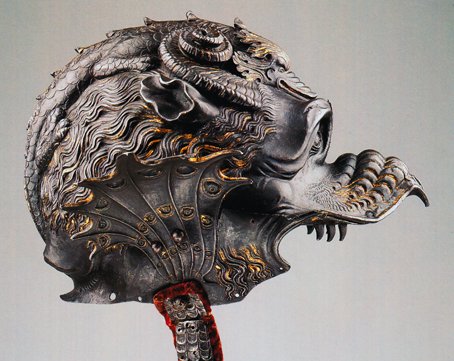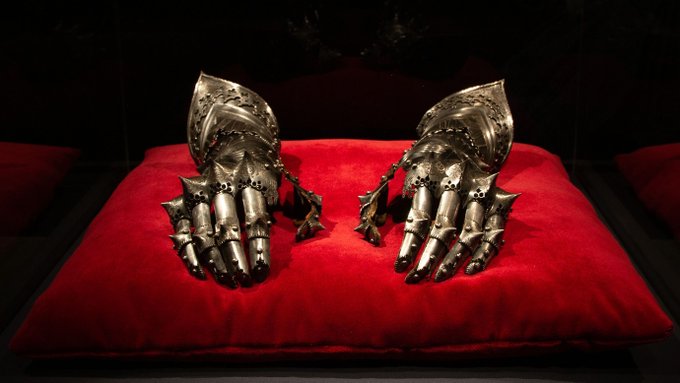Most Incredible Armor In History

May 9, 2023
•12 min read
Coming up is some ridiculously badass armor from the past. Let's explore some amazing medieval armor that looks epic!
Fighting has always been about more than just who has the bigger sword; after all, the poorest tactics never consider their own defense. Armor has evolved through the centuries from basic coverings that protect an army’s infantry to astounding feats of design made to win wars of combat and politics.
It’s insane to think that a set of armor could have that much impact, but after you read this article you’ll see why. Let's explore some examples of ridiculously badass armor and delve into why it existed.Sallet in the Shape of a Lions Head
This incredible piece of metalwork is the earliest surviving example of Renaissance armor all'antica or "armor in the antique style" if you don’t speak Latin. It’s called the Sallet In the Shape of A Lions Head.
Made around 1475, the lion head itself is a golden gilt copper, with the eyes made of glass to look more life-like. The Sallet itself is a shell which fits onto a steel helmet underneath. It represents the head of the Nemean Lion, the famous feline slain and worn by the demi-god Hercules in Greek mythology. Hercules was often used in Renaissance art as a symbol of courage, strength and perseverance. So, walking out on the street back in the day with this strapped to your head was what the kids would call a huge flex.Foot-Combat Helm of Sir Giles Capel
The Foot Combat Helm of Sir Giles Chapel is arguably the finest of its kind to survive from the period around 1510. As part of the retinue of Henry VIII, Capel was a famous challenger of opponents during a tournament summit between England and France in 1520.
The design allowed him to compete in multiple events such as sword fighting and jousting, with a clear field of vision while his eyes were protected. The slight ridge down the center was a purposeful part of the design to help deflect opponents' head blows. As well as looking cool as hell, and arguably influencing modern fencing mask designs!Horse Armor
Cavalry back in the 15th century was essential to hundreds of battle plans. But no matter how well-protected your riders were, their charge would have been pointless if they were riding into battle on the back of a giant target. Alongside their own full coats of armor called ‘barding ’, horses also sported "shaffrons" which provided protection for their heads.
More intricate designs like the one below made for Duke Niklolaus “The Black” Radziwill around 1515 included meticulously crafted eye guards so that the horse could still see while its eyes were being protected.Others from the French Renaissance period were designed as elaborate parade armor to go with their riders’ royal style. The incredible metalwork below is a shaffron of Henry II of France, whose horse was made to look like a fierce dragon in a ‘heroic style’ making specific reference to heroes of literature and legend.Turban Helmet of the Ottoman Turks
Originating from the age of the Ottoman Empire, Ottoman helmets, sometimes known as Turban helmets, were designed for warriors who wore a religious head covering.
European helmet designs fit as snugly as possible to prevent the head from banging against the metal sides when hit, but these helmets were designed around the 14th century to better accommodate the Ottoman soldiers’ religious requirements while providing protection during battle.
Parade Armor of Henry II France
Armor wasn’t just used in battle, but also in the wars of politics and state. Henry the II of France who ruled in the mid-15th century held many wonderful sets of parade armor, but perhaps non more so than that which was designed by Etienne Delaune.
The master engraver designed every inch of the silver and steel carapace with intricate gold details, each one telling a story of the wearer. Figures on the breastplate and back reflect Henry II’s many military achievements, and many others are adornments of powerful arabesque art.This prestigious commission probably involved many of the country's finest master goldsmiths, but it was never designed for any kind of jousts or battle. It’d be like trying to take a Lamborghini off-road: possible, but a very expensive and bad idea.Elephant Armor
Horses weren’t the only animals given armor for battle. Elephants were used for warfare in India for almost a thousand years! 16th Century War Elephants were given giant plates and chain mail coverings to protect vital body parts from their attackers.
In total, it’s estimated these armor sets were comprised of around 8,439 plates weighing in at a huge 159 kg. But that wasn’t all, these OG tanks were also given long, wavy blades which were affixed onto their tusks, of which only four known pairs survive today including the one in the image below.When they charged into battle, they could either stomp their enemy to death or shred them to ribbons. As the elephants were ridden into the lines of their opponents, many of those who had never seen an elephant before assumed these beats naturally had knives protruding from their faces. Now there’s a scare tactic for the ages!
Burgonet
Like a lot of outfits, sometimes it doesn’t matter what you wear, but who you wear. The infamous Filippo Negroli was a Renaissance master of ceremonial armor, producing some of the world's most famous burgonets from the 15th century.
Burgonets were light steel caps used in the late medieval infantry; some included a fitted neckpiece so the head could be turned without exposing the neck. Jaw-dropping examples of these include the Griffon burgonet.It is designed to look like the intricate head of a griffin with an attachable visor. There’s also the Burgonet of Guidobaldo II, Duke of Urbino, which has a detailed wolf snarling about the wearer's face while a dragon perches on top and wings on either side.Straight out of Mordor?! Grotesque Burgonet-steel,gold,textile-1532-35 by armourer Filippo Negroli @state_hermitage
Ferdinand the II Of Austria
What do you get for the man who has everything? Well if you’re buying a gift for the emperor of the Holy Roman order, you’d better be thinking of more than socks. The absolutely insane all’antica armor and matching shaffron masterpiece in the image below were created by Lucio Piccinino in the 15th century.
Prankher Helm
European helmets of the 12th century had one major flaw. Ironically, they didn’t really protect the head very well. But by the mid-13th century, that all changed. The Prankher Helm is an example of a highly improved, 13th-century Pot Helm.
Made from a reinforced, pre-strapped metal plate, it compromised the wearer's field of vision to two narrow slits in favor of full facial defense. Unfortunately, the sheer weight of all this extra metal meant the helmets weren’t suitable for battle, and so were used almost exclusively for tournaments.
Gauntlets of Maximilian I
Back in the day, armor could even be used as propaganda under the right circumstances! The gauntlets below look like they’ve been plucked out of Lord of the Rings, for example.
The gauntlet has been THROWN. 💥 As the grandson of Maximilian I, Charles V reclaimed these gauntlets shortly after his grandfather's death, hoping to preserve Maximilian's memory, See them on view in #MetLastKnight . Learn more at met.org/TheLastKnight .
The Brocas Jousting Helm
Until the 14th Century, helmets seen out on battlefields were the same as those used in jousts. The design was fine for vision but savage blows to the head could be fatal as they weren’t designed to withstand big impacts. So, changes were made to the traditional designs and specific jousting helmets were crafted such as the Brocas Helm.
This was made for the German form of the Joust of Peace, known as the Gestech. It’s a frog mouth helm that has a protruded lower edge of the vision slit which juts forward and upward to prevent a lance from slipping into the jouster’s eyes!Horned Helmet of Henry VIII
Henry VIII was famous for beheading his wives, so what kind of gift do you get a man who’s clearly missing a good head in his life? Obviously, the bizarre Horned Helmet.
It was gifted to Henry VIII by none other than Emperor Maximillian I, the very same man who conquered courts and politics with his choice of armor. The horned helmet was designed by Konrad Seusenhofer, once one of Europe’s most prominent armorers.The level of detail ascribed to the helmet is staggering, from the lines under the eyes of the silver-grill panels to the pockets of stubble on the jaw. Researchers had previously thought that it was designed to depict a fool due to the comically large nose, spiral horns and glasses. Makes you wonder if this was actually a two-faced gift!Jaguar Warriors
Embossing elaborate images of animals from myth and legend onto armor wasn’t as badass as Mayan military captains who went to war wearing the actual skins of those fearsome animals!


Samurai Armor
In feudal Japan, the life of a Samurai meant being constantly on the move. Heavy armor was a burden, so the ingenious design of the Tatami Gusoku became a standard among all classes of Samurai. In English Tatami Gusoku translates to ‘To Fold Armour’, and the wearer was easily able to remove and transport it in a small wooden box when necessary.
This armor was often paired with a Kabuto helmet, which played a symbolic role as well. This 17th-century shell-shaped Harikake Kabuto was made with papier-mache and lacquer affixed to an iron base.Despite perhaps being a little useless in battle, it clearly shows the status of its wearer and the appropriate respect that should be shown. Facial armor components called mengu or men-yori were sometimes fixed to the kabuto, giving wearers a terrifying appearance to the enemy, as well as acting as a strap to keep the kabuto in place. Efficient and scary, no wonder the Samurai ruled Japan for almost 700 years!Polish Winged Hussars
The armor of the Polish Winged Hussars is one of the most badass examples of armor design in history. These angels of death would ride into battle with giant wooden frames fixed to the lower portions of their armor, which carried either ostrich, swan, eagle or goose feathers.





































